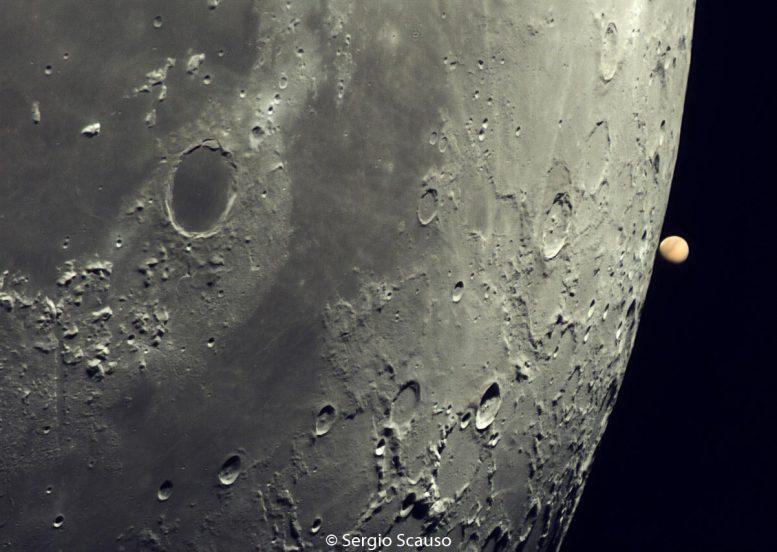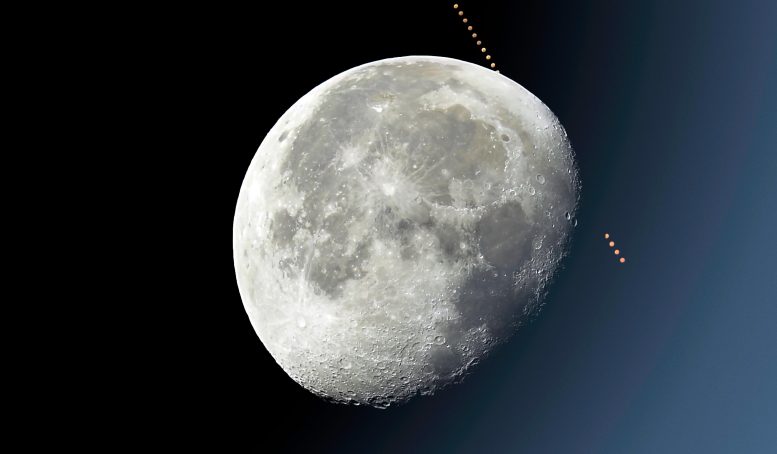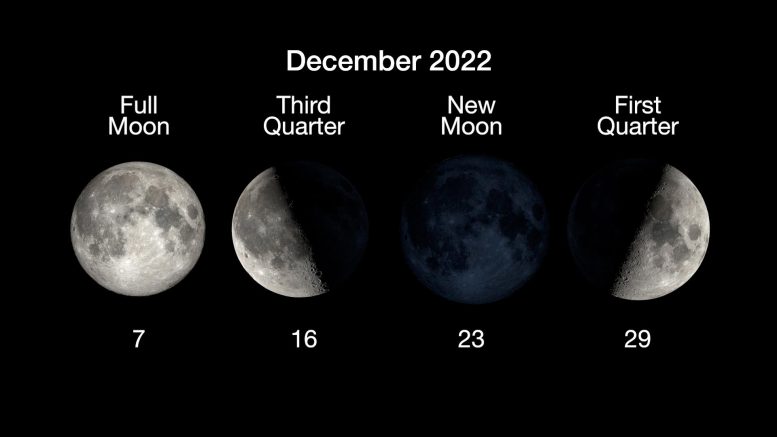
The Moon occasionally moves in front of all of the Solar System’s planets, including Mars. Credit: Sergio Scauso
What are some skywatching highlights in December 2022? The Moon sweeps past Jupiter twice this month, and actually covers Mars completely, in an event called an occultation, on December 7. The event is visible across the U.S., except for the Southeast and East Coast, where the Moon will graze closely past Mars. And throughout the month, you can find Pegasus, the winged stallion, high overhead in the south.
What to look for in December 2022: Mars disappears, and Pegasus rides to adventure. Viewers in most of the U.S. and Europe can watch Mars slip behind the Moon on December 7, and everyone can find the winged horse constellation Pegasus.
- December 1 – Look in the southwest this evening to find the Moon only a couple of finger-widths apart from the brilliant planet Jupiter.
- December 7 – Full moon
- December 7 – The Moon occults, or covers up, Mars tonight. In the U.S., Mars slips behind the Moon for viewers everywhere outside the East Coast and Southeast, where the Moon will appear to just barely graze past Mars. Check your favorite stargazing app or website for the timing of the disappearance and reappearance of Mars.
- December 23 – New moon
- December 25-31 – Check out the Moon and planets at year’s end. Watch each evening as the increasingly full Moon slides past Saturn on the 26th and then past Jupiter on the 28th.
- All month – Find the constellation Pegasus high in the south-southwest after dark. Look for bright Jupiter and find the Great Square of Pegasus about 15 degrees above it.

Lunar occultation of Mars. Credit: Andrés Jobacho
Video Transcript:
What’s Up for December? Your evening planet highlights, including the disappearance of Mars, and the constellation Pegasus.
The month begins and ends with the Moon visiting the giant planets. On December 1st, find the Moon just a couple of finger-widths apart from Jupiter in the evening sky. Then, from the 25th to the 31st, look to the southwest following sunset to see an increasingly full Moon slip past Saturn and then again past Jupiter. Viewers with a clear view to the horizon will be able to search for Venus and Mercury in the fading glow of sunset, just a few degrees above the skyline.
December 7 brings one of those magical moments when the sky changes dramatically before your very eyes. It’s called a lunar occultation, as the Moon passes in front of, or occults, the Red Planet, Mars. The spectacle will be visible in parts of North America, Europe, and Northern Africa. (Viewers in the Southeast and on the East Coast will see the Moon just graze past Mars.) For viewers in the U.S., Mars disappears behind the Moon sometime between about 6:30 and 9 p.m., depending on your location, so check your favorite skywatching app to find the time for your area.
Now, the Moon passes in front of planets in the night sky several times per year. In fact, it generally occults Mars itself at least a couple of times per year. But each occultation is visible from only a small portion of Earth’s surface, so it’s not super common for any particular spot on Earth to see them frequently.
Of course, the Moon passes in front of stars all the time. If you’re watching through binoculars, they just blink right out. But planets are not just points of light like stars – they appear as circular little disks, so planets actually take several seconds to disappear and later reemerge. So if you’re in the viewing zone, enjoy this relatively rare opportunity to watch a bright planet being occulted by the Moon.
Looking high in the southwest sky on December evenings, you can find a constellation named for one of the more fantastical beasts of ancient mythology. That’s Pegasus, the winged horse. In Greek myth, Pegasus rode into adventures with the hero Belaraphon, and later carried the thunderbolts of Zeus himself, who rewarded him by placing him among the stars.
Pegasus is one of the largest of the 88 constellations. Its most prominent feature, and the key to finding it in the sky, is this asterism, or pattern of stars, called the Great Square. These four stars of roughly equal brightness form the central part of the horse’s body.
This December, it’s easy to locate Pegasus, thanks to brilliant Jupiter. Face southward to find the giant planet about halfway up the sky, with the Great Square beginning about 15 degrees to the north of it.
Pegasus is a useful constellation for stargazers, as it’s a good starting place for finding your way to other features in the night sky. The constellation itself contains a number of dazzling deep-sky objects, including globular cluster M15, and the tangled galaxies of Stephan’s Quintet. With this year drawing to a close, here’s hoping you seek out the winged stallion Pegasus, as you ponder what new adventures await in the next year.
Here are the phases of the Moon for December.

The phases of the Moon for December 2022. Credit: NASA/JPL-Caltech
Stay up to date with all of NASA’s missions to explore the solar system and beyond at nasa.gov. I’m Preston Dyches from NASA’s Jet Propulsion Laboratory, and that’s What’s Up for this month.









Hi I watched the video and its very interesting…